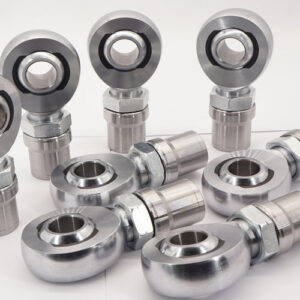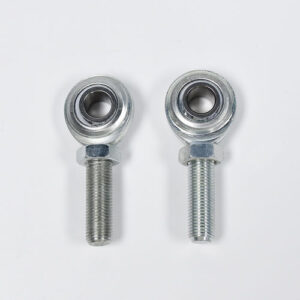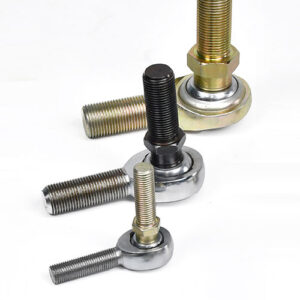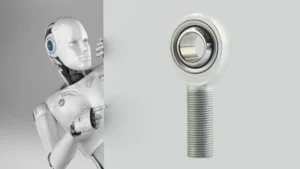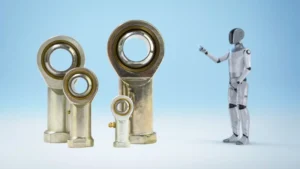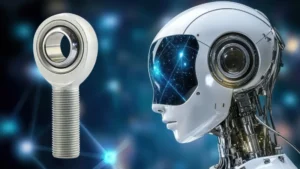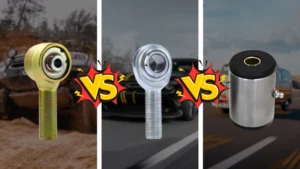If you’ve been sourcing or working with rod ends for a while, you’ve probably come across heim joint types like 2-piece, 3-piece, or injection-molded. Sounds simple enough, right? But once you dig in, it’s not always clear what makes them different—or when to use which.
That’s exactly what this article is for. We’re cutting through the noise and giving you a practical breakdown of the three most common heim joint types. No fluff, no theory dumps—just what matters for real-world applications.
What is a 2-Piece Heim Joint?
If you’ve ever handled a Heim joint that looked like it was just a ball pressed into a metal housing—you’re probably looking at a 2-piece rod end. It’s the leanest and most cost-effective version out there, designed for simplicity above all else.

Spherical ball
Housing
As shown in the image ‘Male Thread 2-Piece Rod End’ above, a 2-piece Heim joint is made up of just two components:
- A spherical ball (typically made from 52100 bearing steel or stainless steel, heat-treated and precision ground)
- A housing (body) that also functions as the race (usually carbon steel, chromoly, or stainless, sometimes zinc-plated)
There’s no separate liner or internal race. The ball sits directly in a machined spherical cavity inside the body. This simplicity is both its strength and its limitation.
In terms of engineering design, 2-piece joints are what we call a metal-to-metal contact solution, with no intermediary material to reduce friction or absorb shock. That makes them more vulnerable to wear under continuous motion, but also gives them a solid, responsive feel in static or low-frequency applications.
- Cost-effective for low-load tasks — Ideal when volume matters more than fine-tuned performance.
- Lightweight and compact — Fewer parts, lower mass, easy integration into tight designs.
- No fuss installation — No liner orientation or torque preloading to worry about.
- Tolerant of slight misalignment — Still allows angular movement in control linkages.
- No wear-resistant layer — Metal-on-metal contact means quicker degradation under oscillating or high-load conditions.
- Not suitable for high-impact — Can deform or loosen under heavy or shock loading.
- One-way trip — These are non-rebuildable. Once worn, they need full replacement.
- Prone to play over time — Especially if used without dust protection in dirty environments.
In short, if you’re designing for light loads and clean environments—and want to keep things affordable—the 2-piece rod end is a solid choice. Just know its limits, and don’t expect it to hold up under racing suspension loads or heavy industrial vibration.
What is a 3-Piece Heim Joint?
When the application gets serious—think motorsports, off-road suspension, or heavy-duty industrial movement—3-piece Heim joints step in. These joints are designed for strength, longevity, and smoother articulation under real stress.
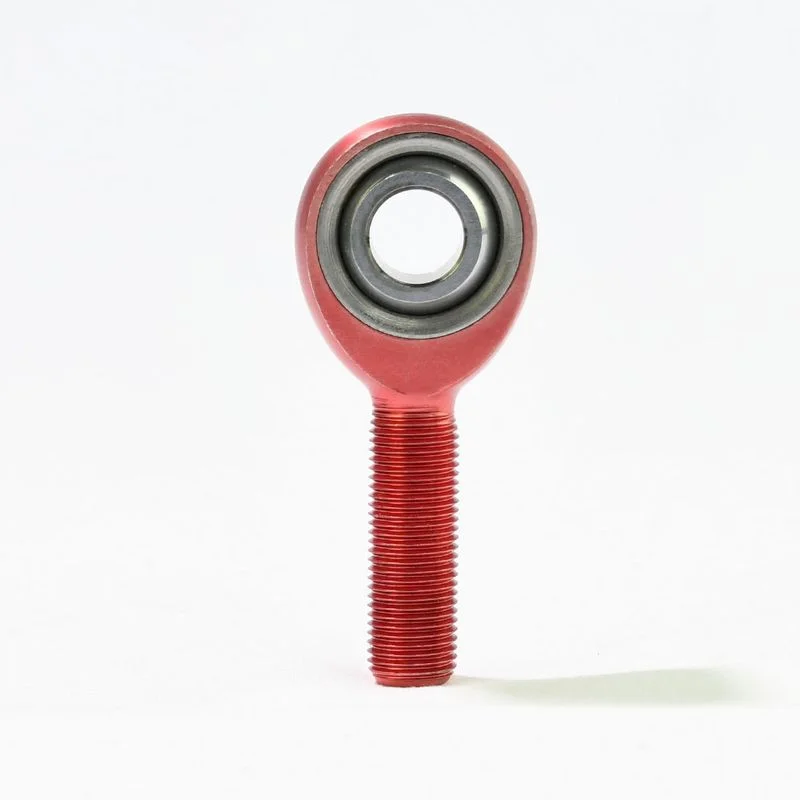
Spherical ball
Housing
Race
As shown in the image ‘Anodized Red Aluminum 3-Piece Heim Joint’ above, unlike the 2-piece version, a 3-piece Heim joint consists of:
- A spherical ball, usually made of heat-treated, precision-ground 52100 bearing steel or stainless steel
- An inner race (or liner), which sits between the ball and housing
- A housing (body), typically alloy steel, stainless, or chromoly—often zinc-plated or black-oxide coated
The race material can vary: it might be PTFE for self-lubrication (here’s why PTFE is commonly used in rod ends), bronze (for oil retention), or injection-molded nylon (for lower friction and noise). This middle layer acts as both a load distributor and wear barrier—offering much greater durability than the direct-contact structure of a 2-piece
Additionally, these joints are often preloaded for tight tolerance, and some even allow torque adjustment during assembly.
- High load capacity — engineered for serious axial and radial force
- Durable — better wear resistance, especially with PTFE or bronze races
- Smooth articulation — ideal for frequent or high-speed movement
- Optional adjustability — preloading and torque control available in some designs
- Higher cost — more components, more machining, higher-grade materials
- Slightly heavier — more material layers add weight
- Overkill for light-duty use — can be excessive if performance isn’t needed
So if you need performance that lasts—especially in systems that flex, pivot, or carry vibration—3-piece rod ends are where it’s at. They’re built to take punishment without falling apart, which is exactly why they’re the go-to for suspension systems, race vehicles, and industrial machinery.
What is an Injection-Molded Heim Joint?
If you’re working on designs where smooth operation, vibration damping, and cost-efficiency matter more than brute force, then you’ve probably encountered the injection-molded heim joint. These joints often fly under the radar, but they’re widely used in automation equipment, light-duty linkages, and even OEM setups where price-to-performance balance is key.
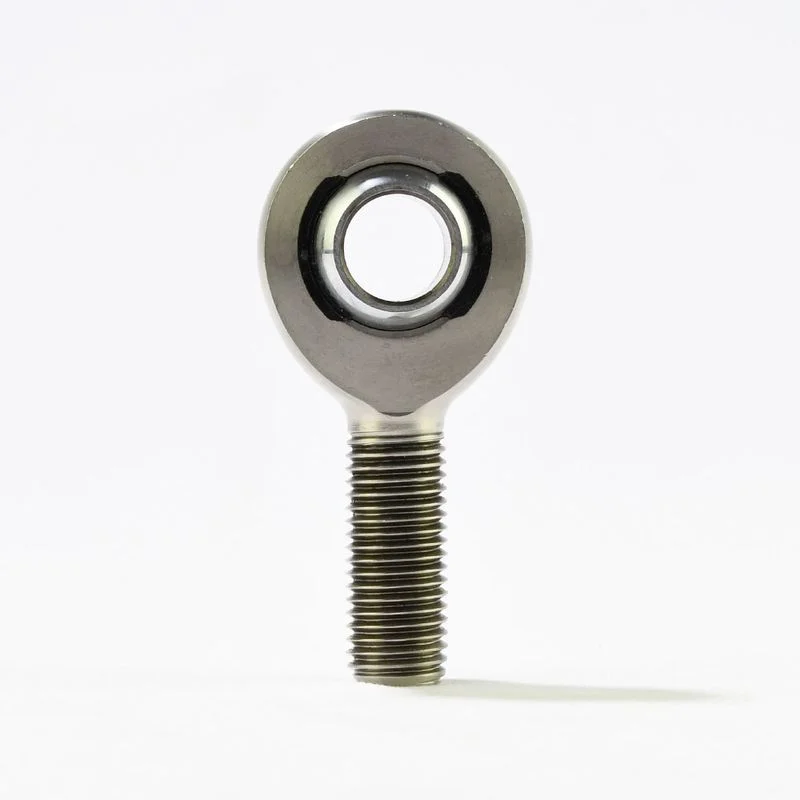
Spherical ball
Housing
Race
As shown in the image ‘Anodized Red Aluminum 3-Piece Heim Joint’ above, structurally speaking, an injection-molded heim joint still follows the three-part format:
- A spherical ball, usually steel or stainless steel, same as other rod end types
- A liner or race, made from an injected polymer, typically reinforced nylon with PTFE.
- A housing, structurally similar to the 3-piece Heim Joint.
So yes—technically, it’s a type of 3-piece heim joint. However, because of how it’s manufactured and where it’s used, most engineers treat it as its own category. It’s less about interchangeable liners and more about the automated injection process, which creates a zero-clearance fit and excellent vibration damping.
- Vibration Damping — The injected liner absorbs vibration and road noise, making it ideal for automotive suspension.
- Zero-Clearance Fit — The molding process creates a tight seal that naturally resists dirt and moisture ingress.
- Maintenance-Free — Advanced polymer liners (like PTFE/Nylon) are self-lubricating and require no greasing.
- Cost-Efficient — Automated injection molding significantly reduces production costs for high-volume orders.
- Temperature Limits — The polymer liner cannot withstand the extreme heat that a metal-on-metal joint can.
- Liner Deformation — Under extreme loads, the plastic liner may compress or deform sooner than a solid steel race.
- Not Rebuildable — The unit is sealed; once worn, it must be replaced entirely.
- Chemical Sensitivity — The liner material may react to certain harsh industrial solvents.
In short, injection-molded rod ends are a smart solution when you’re not pushing the limits—but still want clean articulation, low friction, and affordable scalability. And while they share the same basic architecture as 3-piece designs, they deserve their own category due to their unique materials, molding methods, and performance profile.
Detailed Comparison: Structure, Performance, and Manufacturing
Structure
At a glance, all Heim joint types might look similar—but their internal makeup tells a different story.
| Type | Core Structure | Liner/Race | Housing |
|---|---|---|---|
| 2-Piece | Ball + Housing | None | Metal body acts as race |
| 3-Piece | Ball + Race + Housing | PTFE, bronze, or nylon | Chromoly steel, carbon steel, stainless steel, aluminum |
| Injection-Molded | Ball + Injected Race + Housing | Reinforced nylon with PTFE | Chromoly steel, carbon steel, stainless steel, aluminum |
- To start with, 2-piece joints are the simplest—just a ball pressed directly into a metal body.
- In comparison, 3-piece joints insert a dedicated liner (race) between the ball and body, improving movement and lifespan.
- Meanwhile, injection-molded joints follow the same layout but rely on molded materials to form the liner.
So yes, the injection-molded version is technically a 3-piece—but it’s built so differently, most engineers treat it as its own class.
Performance
When it comes to performance, the differences go well beyond structure.
| Type | Load Capacity | Friction | Lifespan | Noise/Vibration |
|---|---|---|---|---|
| 2-Piece | Low to Medium | High (metal-to-metal) | Shorter | Moderate to High |
| 3-Piece | Medium to High | Low (with liner) | Long | Lower noise |
| Injection-Molded | Low to Medium | Low | Moderate | Quiet, but less stable under stress |
- 2-piece joints are great for static or light-motion setups, but friction and wear build up quickly.
- In contrast, 3-piece designs shine under load—they’re the most durable and stable during high-frequency articulation.
- For lower-stress movement, injection-molded options handle articulation well, but they aren’t made for high-impact jobs.
If you need quiet, smooth, and clean motion—go molded. If you need strength and lifespan—go 3-piece.
Manufacturing
Understanding how each heim joint type is made helps explain their price, performance, and limitations.
| Type | Manufacturing Method | Cost | Customizability |
|---|---|---|---|
| 2-Piece | Machining + Swaging | Low | Low |
| 3-Piece | Precision machining + Race insertion | Medium to High | High |
| Injection-Molded | Polymer injected into metal housing | Low (mass production) | Medium (depends on tooling) |
- To put it simply, 2-piece joints are cheap and easy to produce in large quantities, but they lack design flexibility.
- By comparison, 3-piece joints take more time and precision, but you get full control over preload, liner material, and fit.
- As a result, injection-molded joints win on cost per unit—especially when you’re scaling production—but tooling setup is a bigger upfront investment.
How to Select Heim Joint Types in Different Applications?
Off-Road & Motorcycles
Off-road setups face violent articulation, sudden impacts, and dirty environments. Suspension links and control arms here absolutely demand 3-piece heim joints, ideally with PTFE liners or even sealed options. Avoid anything plastic or unlined—grit and vibration will destroy them in no time.
Automotive & Racing
For racing chassis, steering linkages, and sway bars, precision and minimal play are key. Use preloaded 3-piece rod ends with high-strength housings like chromoly. In non-critical spots (e.g., cable mounts), 2-piece joints may suffice—but never in high-speed load paths.
Agricultural Machinery
Rod ends in agricultural applications deal with mud, vibration, and inconsistent maintenance. Use 3-piece joints for moving or pivoting arms, ideally with grease fittings or bronze races. 2-piece heim joints can be used in throttle or adjustment rods, but not on structural pivots.
Industrial Automation
Automation arms and jigs benefit from injection-molded rod ends—quiet, smooth, and corrosion-resistant. But for high-cycle axes or where precise preload matters, 3-piece heim joints with PTFE races offer better repeatability and stability over time.
Heavy Equipment
Think excavators and cranes: high shock loads, frequent articulation, and harsh conditions. 3-piece heim joints with metal-to-metal races (like copper or PTFE) hold up best. 2-piece rod ends will deform or loosen under repeated hammering forces—avoid them here.
Aerospace
In aerospace applications, weight matters, but so does precision. 3-piece heim joints with lightweight housings and PTFE races dominate here. In non-load areas, injection-molded versions or even composite rod ends may be acceptable, but always verify with spec standards.
Robotics & Precision Equipment
In robotics area, high-frequency, low-load articulation is where injection-molded rod ends shine. Their quiet movement and light weight suit end effectors, sensor gimbals, and tensioners. When repeatable motion is critical, go with low-friction 3-piece rod ends.
Marine & Offshore
In the marine environment, Saltwater is the enemy here. Use stainless steel 3-piece joints with sealed or self-lubricating liners. Avoid carbon steel 2-piece joints—they’ll seize or rust rapidly. In non-structural connections, injection-molded rod ends with UV-resistant plastics can work well.
Mining and Energy
Expect abrasive dust, heavy load spikes, and minimal maintenance windows. Choose 3-piece rod ends with reinforced races, grease ports, and protective coatings. The mining and energy environments will shred plastic-based joints—injection-molded types are not suitable here.
More Ways to Classify Heim Joint Types
While the 2-piece, 3-piece, and injection-molded categories cover most use cases, real-world engineering often calls for more specific features. Depending on your application, you might care about factors like serviceability, corrosion resistance, angular load capacity, or weight savings.
Here are nine more ways to classify Heim joints—each with its own advantages when used in the right context.
| Type | Structure & Materials | Key Features | Typical Applications |
|---|---|---|---|
| One-Piece (Solid Rod End) | Ball and housing are machined or forged as one unit | Extremely strong, no seams, high rigidity | Aerospace, military, crash-safe mechanisms |
| Four-Piece | Ball + 2 races + housing | Distributes load better, better for heavy impact | Industrial arms, mining joints |
| Self-Lubricating | 3-piece with PTFE or oil-impregnated race | Maintenance-free, smooth motion | Robotics, food processing |
| Angular Contact | Race or ball offset to support angular loads | Handles both radial and axial loads | Steering shafts, suspension pivots |
| Rebuildable Rod End | Separate housing, spherical ball, bushings, washer, and snap ring. | Fully serviceable and customizable; replace worn parts instead of entire joint; extended lifespan. | Off-road racing, high-performance suspension systems, heavy-duty steering linkages |
| Rod End with Ball Bearing | Ball includes internal precision bearing | High-speed rotation, ultra-smooth feel | Throttle linkages, control arms in motorsports |
| Sealed Heim Joint | Standard joint with integrated dust/water seal | Protects against dirt, water, longer service life | Off-road vehicles, marine applications |
| Greasable Rod End | Housing includes grease port and channel | Suitable for dirty/heavy-duty environments | Agriculture, construction, mining |
| Metal-to-Metal | Ball and race both metal, no liner | Highest rigidity, less play, can be re-tightened | Racing, high-load pivoting arms |
| Weldable Heim Joint | Housing has weld-ready base, no threads | Directly welded to structure | Custom fabrication, suspension tabs |
| Composite Heim Joint | Made from carbon fiber or high-strength polymer | Lightweight, corrosion-resistant | UAVs, light robotics, cleanrooms |
Get It Right: Picking the Perfect Heim Joint Type
By now, you’ve seen that not all heim joint types are created equal. Whether you’re choosing between a basic 2-piece rod end for a throttle linkage, a heavy-duty 3-piece heim joint for suspension, or a lightweight injection-molded rod end for a robotic arm—each type has a clear role to play.
Ultimately, understanding the structure, performance, and application fit isn’t just about specs—it’s about making the right call for your specific build. So next time you’re scanning catalogs or talking to a supplier, you’ll know exactly what to look for—and why it matters.
If you’re still unsure which heim joint types fit your use cases, don’t hesitate to reach out. The right joint not only improves performance—it saves time, money, and a whole lot of headaches.
Selecting between 2-piece, 3-piece, or injection-molded is only one step. For the complete process of choosing heim joints, explore our Wholesale Buyers’ Guide.



